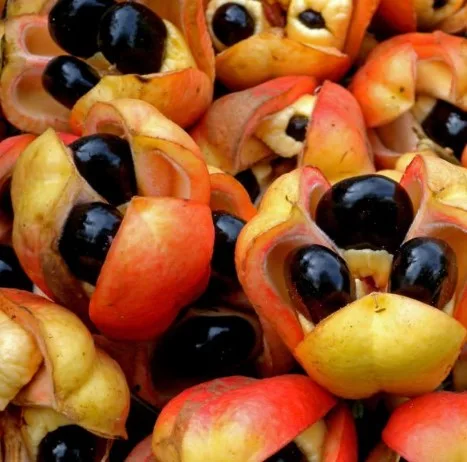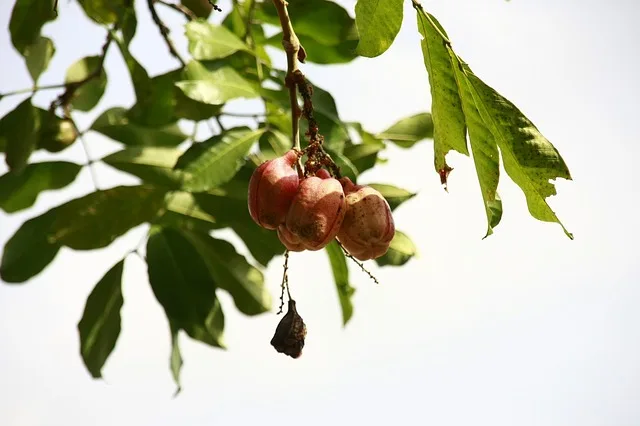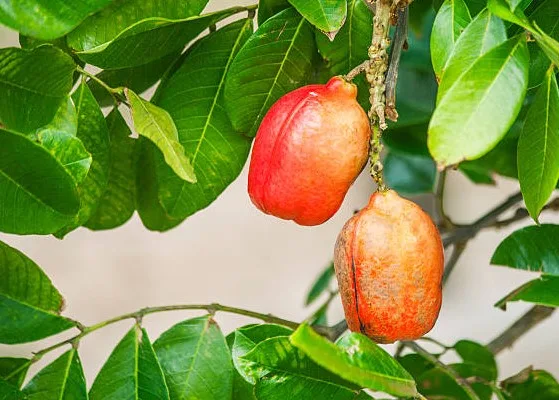Introduction
Have you ever wondered about a fruit that is both delicious and potentially dangerous? Meet Ackee, the national fruit of Jamaica, celebrated for its creamy texture and mild flavor yet infamous for its toxicity when unripe.
What is Ackee?
Ackee, scientifically known as Blighia sapida, is a tropical fruit native to West Africa but is now predominantly associated with Jamaican cuisine. This unique fruit offers not only a fascinating taste but also a host of health benefits. However, proper preparation is key, as the unripe fruit contains toxins that can cause severe illness.
In this article, we’ll explore everything you need to know about Ackee, from its origins and culinary uses to its nutritional value, safety precautions, and cultural significance.
Table of Contents
What Does Ackee Taste Like
Appearance and Taste
Ackee is a curious fruit, with its bright red, pear-shaped pods that burst open when fully ripe, revealing creamy, yellow arils that resemble scrambled eggs. The taste of Ackee is mild and slightly nutty, making it the perfect companion for savory dishes, especially the famous Jamaican dish, Ackee and Saltfish.
Nutritional Value: Packed with Benefits
While Ackee may be beloved for its flavor, it also boasts impressive nutritional benefits. The fruit is rich in essential fatty acids, making it a heart-healthy choice. Here’s a breakdown of the key nutrients found in Ackee:
- Healthy Fats: Ackee is a good source of linoleic and stearic acids, which support heart health.
- Vitamins: It provides vitamins A, C, and B3, contributing to good vision, skin health, and energy metabolism.
- Minerals: The fruit contains important minerals like calcium, potassium, and iron, essential for bone health and proper muscle function.
- Protein: Ackee offers a moderate amount of protein, making it a satisfying addition to plant-based meals.

Health Benefits of Ackee
Ackee’s nutrient profile offers several health benefits:
- Supports Heart Health: The healthy fats in Ackee promote good cholesterol levels and reduce the risk of heart disease.
- Boosts Immune Function: Its vitamin C content strengthens the immune system, helping to ward off infections.
- Enhances Energy Levels: Vitamin B3 aids in converting food into energy, keeping you energized throughout the day.
- Promotes Digestive Health: Ackee is rich in fiber, supporting a healthy digestive system and preventing constipation.
Common Uses in Jamaican Cuisine
Ackee has become a staple in Jamaican kitchens, where it is cherished for its versatility. The most famous dish that features this fruit is Ackee and Saltfish, a savory meal often enjoyed for breakfast or lunch. Ackee is sautéed with salted cod, onions, peppers, and spices to create a flavorful and satisfying dish. Apart from this iconic recipe, Ackee is also used in soups, stews, and curries.
Ackee’s versatility extends beyond the iconic Ackee and Saltfish dish. Here are a few other popular ways to enjoy this fruit:
- Ackee Patties: Similar to Jamaican beef patties, these pastries are filled with Ackee, vegetables, and spices.
- Ackee and Callaloo: A vegetarian dish that pairs Ackee with callaloo, a leafy green similar to spinach.
- Ackee Stew: Ackee can be simmered in coconut milk with herbs and spices, creating a creamy, savory stew.
Safety First: Ackee’s Toxicity
While Ackee is a nutritional powerhouse, it must be handled with care. The fruit contains toxic compounds called hypoglycin A and B when unripe. Consuming unripe Ackee can lead to “Jamaican Vomiting Sickness,” a potentially fatal condition. Hypoglycin A levels drop significantly once the fruit fully ripens and the pod opens naturally.
Safe Preparation Guidelines:
- Wait for Ripeness: Only consume Ackee that has naturally opened on the tree. This is the clearest indicator of ripeness.
- Remove the Seeds and Pith: The glossy black seeds and the pink pith around the yellow flesh must be discarded, as they remain toxic even after ripening.
- Boil Before Cooking: Boiling Ackee for at least 10 minutes helps to eliminate any residual toxins and ensures the fruit is safe to eat.
- Cook Thoroughly: Once boiled, Ackee can be sautéed or incorporated into various recipes. Cooking it with seasoning enhances its flavor while ensuring safety.
Ackee’s Cultural Significance: A Journey from Africa to the Caribbean
Ackee was first brought to Jamaica in the 18th century during the transatlantic slave trade. Since then, it has become deeply ingrained in Jamaican culture, symbolizing the resilience and creativity of the Jamaican people. Ackee’s arrival in the Caribbean and its subsequent cultivation marked the beginning of its role as a staple food source.
Though Ackee is now synonymous with Jamaican cuisine, it originally hails from West Africa, where it was primarily grown in countries like Ghana and Nigeria. In Jamaica, it thrived in the island’s tropical climate and quickly became a vital part of the nation’s food identity. The national dish, Ackee and Saltfish, is a testament to the fusion of African and Caribbean culinary traditions.

Cultivation and Harvesting
Ackee grows best in tropical climates, thriving in both West Africa and the Caribbean, particularly in Jamaica. The tree can grow up to 10 meters tall and produces fruit year-round, although the main harvest season is between January and March. Farmers must take great care in harvesting, ensuring that only naturally ripened fruits are picked to avoid toxicity. In Jamaica, Ackee is such an essential part of the culture that it’s even featured on the national coat of arms.
Interesting Facts or History
- Named after a British Captain: The fruit was introduced to Jamaica from West Africa in the late 18th century and is named after Captain William Bligh, who brought it to the island.
- National Symbol: Ackee is not only a culinary staple but also a cultural icon in Jamaica, where it’s regarded with pride as the national fruit.
- Ackee in Pop Culture: Beyond food, Ackee has found its way into music, literature, and art, symbolizing the spirit and identity of the Jamaican people.
FAQs About Ackee
Q: How can I tell when Ackee is safe to eat?
A: Ackee is safe to eat when its pod has naturally opened, revealing the yellow flesh and black seeds.
Q: Is Ackee available outside of Jamaica?
A: Yes, canned Ackee is available in many countries, especially in Caribbean and specialty grocery stores. However, fresh Ackee can be harder to find outside of tropical regions.
Q: How does Ackee compare to other tropical fruits in terms of nutrition?
A: Ackee is unique due to its high content of healthy fats, which sets it apart from sweeter tropical fruits like mangoes or bananas.
Q: Can I eat Ackee raw?
A: No, Ackee must be boiled and thoroughly cooked before consumption to avoid toxicity
Conclusion: Exploring Ackee’s World
Ackee is a fruit that stands out for its fascinating combination of taste, nutrition, and cultural significance. From its creamy texture and subtle flavor to its rich history and importance in Jamaican cuisine, Ackee is a fruit worth trying—just be sure it’s ripe! Whether you’re a foodie or simply curious about trying something new, this tropical fruit is a must-try for anyone looking to explore Caribbean flavors.
GET IN TOUCH
Ready to dive into the world of Ackee?
Try your hand at making the classic Jamaican dish, Ackee and Saltfish, or explore other creative ways to incorporate this exotic fruit into your meals.
“Don’t miss out! Explore our latest articles on. https://foodillusion.com/”





